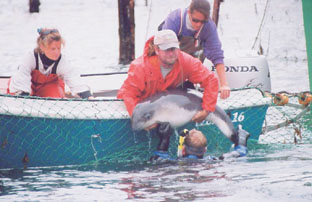
![]()
Volume 7, No. 3
Promoting Cooperation to Maintain and Enhance
Environmental Quality in the Gulf of Maine
|
||||||||||
|
|
|
|
|
|
|||||||
|
|
|
|
Browse the archive |
|
|
|
|
Gulf Log
New England’s unpredictable clime
 |
| The Grand Manan Whale and Seabird Research Station in New Brunswick has received a grant for $9,846 from the Gulf of Maine Council for its Harbour Porpoise Release Program. In total, the Council awarded $131,700 this summer to 14 organizations. The awards will help fund initiatives in the states and provinces that support the Council’s action plan goals to safeguard human health, maintain ecosystem integrity and protect and restore coastal and marine habitats. The entire list of grant recipients and their projects is available on the Council’s Web site at www.gulfofmaine.org. |
Not only are weather patterns in New England more changeable and more extreme than almost anywhere in the United States, they report, New England is the ultimate destination of nearly all storm tracks nationwide. Zielinski is the Maine State Climatologist and an associate research professor in the Institute for Quaternary and Climate Studies. Keim is the New Hampshire State Climatologist and a member of the Climate Change Research Center at the University of New Hampshire.
“What we want people to understand,” Zielinski says, “is the variability of New England’s weather. Our weather can vary more over a relatively small geographic area than weather almost anywhere else in the country. To confirm that, you only need to look at the plant hardiness zones for New England. We go from Zone 7 on Cape Cod to Zone 3 in northern Maine. That’s a huge change in a few hundred miles.”
Zielinski and Keim explain New England’s annual cycle in terms of skiing, coping with mud, enjoying beaches and looking at foliage. They present information about the causes of daily, annual and multi-year variations in temperatures and precipitation. But they also discuss trends over the past century and address the potential for regional changes related to global warming.
Records for the past century support a slight warming of the average temperature across much of New England. And there is evidence, says Zielinski, for a climatic boundary that separates Maine from the rest of New England.
The book contains photographs, graphs and maps to help observers understand the forces at work behind the weather. The authors offer an in-depth explanation of the latest theoretical insights into New England’s weather along with stories and lore about the region’s atmospheric peculiarities. To order New England Weather, New England Climate, go to www.unep.edu.
Coastal stewardship expands in Maine
They come from every walk of life. There’s a famous chef, a banker, a journalist, a real estate broker, a quilter and a history teacher. What they all share is a love for Maine and a desire to help preserve the state’s unique sense of place.
They spend five weeks studying Maine’s complex ecosystems. They tour woodlands, vernal ponds, beaches, tide pools and an alewife stream. They take water samples and learn to measure clarity, salinity, oxygen content and pollution. They study phytoplankton, lobsters, horseshoe crabs and anadromous fish. They know the difference between point source and nonpoint source pollution and between a forever-wild conservation easement and an agricultural one. They understand Maine’s geology and how it influences the land’s fertility and the critters that crawl and fly over it and swim its waters.
They are Midcoast Stewards, participants in a unique program to protect the cultural and natural resources in a region from the east side of Merrymeeting Bay to the St. George Watershed. In exchange for their training, stewards volunteer to help conservation groups in their hometowns. A wide variety of government, educational and conservation organizations support the program—through grants or by providing teachers and classroom space—because it fits their own educational outreach goals and provides them with a pool of educated volunteers.
 |
| David Keeley the Acting Director of the Maine State Planning Office has received the Coastal Steward of the Year Award, as part of the annual Walter B. Jones Awards given by the National Oceanographic and Atmospheric Administration. The awards honor excellence in unique ocean resource management programs, as well as in public and private endeavors to conserve U.S. coastal regions. For more than 25 years, Keeley has worked on coastal policy and planning and achieved many notable successes. He helped to create the Wells National Estuarine Research Reserve and directed the Maine Coastal Program for many years. In 1989, he was instrumental in forming the Gulf of Maine Council on the Marine Environment and is a long-time member of its working group. Photo: David Keeley with son Chris |
The idea for the program originated in an earlier one—the Penobscot Bay Stewards—that is now going into its ninth year of training stewards.
And what drives the volunteers? From comments they made at a meeting last spring, it is a strong desire to learn about their communities and to give back to them. Anyone with an interest in learning more can contact Theresa Torrent-Ellis, Maine Coastal Program, at (207) 287-2351.
—Sam Low
Bad news for sharks
This summer the National Marine Fisheries Service released its latest population assessment and management recommendations for the Atlantic spiny dogfish shark, and it doesn't look so good. The assessment shows a 75 percent decline in mature females since 1989, when the fishery targeting them began. The fish are late to mature, leaving them susceptible to overfishing. The Atlantic States Marine Fisheries Commission (ASMFC) earlier this year raised the dogfish quota in state waters (first three-miles off shore) to more than twice the level recommended by scientists and dictated by the 2002 ASMFC rebuilding plan. To see the assessment search the NMFS Web site beginning at: http://www.nmfs.noaa.gov.
In Nova Scotia, animal rights activists staged a protest at the Eastern Passage’s annual shark derby in late July, which attracted hundreds of people to Fisherman's Cove. The protesters said the event contributes to a steady decline in the population of blue sharks. Spokeswoman Angie Lewis told the Halifax Chronicle that the issue is two-pronged: species conservation and animal cruelty. She said shark derbies are “unnecessary, cruel and, at this point, ecologically devastating.”
Lewis pointed to scientists’ warnings about declining shark stocks in the North Atlantic, due to overfishing, as motivation for ending derbies [see Gulf of Maine Times cover story, Summer 2003].
Restoration grants available
The U.S. Gulf of Maine Council through a partnership with the National Marine Fisheries Service, an agency of the National Oceanic and Atmospheric Administration (NOAA Fisheries) is seeking proposals for habitat restoration projects. The funding, totaling nearly $300,000 U.S., is available as part of a three-year partnership between the Council and NOAA Fisheries to restore coastal fisheries habitat in the Gulf of Maine. Since 2001, NOAA and the Council have funded 22 restoration projects in three states and one province that borders the Gulf of Maine. Those activities include dam removal, fish passage improvements, invasive species removal and restoring the tidal flow to restricted salt marsh environments. The request for proposals is available on the Gulf of Maine Council Web site at www.gulfofmaine.org/opportunities. A letter of intent is due by Sept. 29 and the full application is due Nov. 14. For further information contact Jon Kachmar at (207) 287-1913 or jon.kachmar@ maine.gov.
Whale populations too low to hunt
Scientists have vastly underestimated the number of humpbacks and other great whales that inhabited the North Atlantic before the advent of whaling, according to geneticists from Harvard and Stanford universities. Their findings, published this summer in the journal Science, could represent a setback for countries that advocate lifting a 17-year moratorium on commercial whaling established by the International Whaling Commission.
The worldwide population of humpback whales, estimated at 20,000, may have been as high as 1.5 million before the advent of 19th-century commercial whaling, according to Joe Roman, a Harvard graduate student and lead author of the study, and Stephen R. Palumbi, a professor of biological sciences at Stanford.
“It is well known that hunting dramatically reduced all baleen whale populations, yet reliable estimates of former whale abundances are elusive,” the scientists wrote. “Whaling logbooks provide clues, but may be incomplete, intentionally underreported or fail to consider hunting loss.”
To assess the accuracy of historic whaling records, the scientists examined the amount of genetic variation—the difference in DNA from one individual whale to another—to calibrate the historic size of the population.
They focused on the genetics of humpback, fin and minke whales—species decimated in the mid-19th and early-20th centuries by the demand for whale oil (for lamps, candles, soaps and perfumes), baleen (for whips, corsets and other devices) and meat. Humpbacks, fins and minkes are found in the North Atlantic including the Gulf of Maine.
“The genetics we’ve done of whales in the North Atlantic says that, before whaling, there were a total of 800,000 to 900,000 humpback, fin and minke whales—far greater numbers than anybody ever thought,” Palumbi said.
In 1986, the IWC declared a worldwide moratorium on commercial whaling—a position respected by all 51 IWC member-nations except Norway, which openly permits the annual sale and slaughter of about 550 North Atlantic minke whales, and Japan, which allows certain species in Antarctica and the North Pacific to be harvested for “scientific purposes.” Under IWC guidelines, a majority of members could lift the moratorium and allow other countries to hunt whales in regions where the population has reached 54 percent of its original carrying capacity.
Instead of catering to commercial whaling interests, a number of scientists and policy makers have urged the IWC to encourage the development of commercial whale watching—an industry that generates more than $1 billion in annual revenues worldwide, according to a June 2003 report by the conservation group World Wildlife Fund.